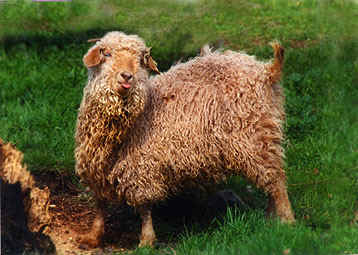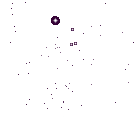~~* Black Sheep Newsletter............Issue 102............Winter 2000 *~~
 †
†
THE HOMESTEAD: Breeding, Appraisals of Stock, and the Gathering
A dark foreboding sky, deepest gray slate, paints the horizon around our mountain homestead. It glowers, but today it is only a wry face, a "barking dog with no bite." The sun is already playing peek-a-boo through the cloud cover. A vivid rainbow is beckoning me outdoors. I wrap myself in a handwoven mohair shawl, light and airy, and walk outside.![]()
Winter in Oregon has begun, which means that the heavy Oregon rains have been making their appearance. The torrents unleash sporadically, mostly while we sleep. Stan and I hear the rain hit the roof as we snuggle warmly in quilts, and hope the best for the goats. They are all well hidden in their "forts" – three sided little lean to 's in their pens. Even so, I hop out of bed early to check on the flock and make sure all is well.![]()
I expect even more rain to fall in January and February. My current pair of galoshes have holes in them. A new pair is needed every year. Stan and I both work hard and our rubber boots attest to the fact.![]()
Our goats were not sheared this autumn. They still sport long tendrils. As we head into the cold and wet months - if we shear, we will "shear long" – that is leave about ¾" to ½" of fiber on the goats. That seems to work well for this small operation. A dry cold never seems to do much harm to newly shorn goats. It is, rather, a wet chill that will stress the goats too heavily, so we avoid shearing during any prolonged period of inclement weather.![]()

Bubba's baby, B1
Winter Browse and a New "Shepherdess"
We have been letting the goats out to browse daily. Our new guardian dog joins them. The white Italian Maremma, feminine featured "Bo Peep" ("Peeps") has been a most welcome addition, having joined us a month ago. Though four years old when she came to this ranch, she has known nothing other than protecting livestock from her puppyhood and understood what her job would be from the get-go. She adopted our own herd immediately. Uzi, our two year old Kuvasz guardian (a loyal lone soldier all this time) now has the "back up" help we have longed to give him. Hearing him in his lonely night vigils trying to defend his charges from a pack of yodeling coyotes moving in closer and closer, was not easy for us, as shepherds. He heartily welcomed Peeps, too!![]()
Ahhh, this makes my shepherding task a lot less formidable! Peeps established her own routine early on. We open the gate to he goat pen (where she lives with the goats). They exit, as does she. She considers it her duty to first skirt the entire perimeter of the fence line, making a bee-line toward that wooded mountainside. Long before the goats meander up the mountain she has assured herself that all is well. She then follows the flock as they make their rounds. Every night she brings them back to the gate and waits for us to open it. Like an astute ranch hand, she 's cut out for the job.![]()
I enjoy a good hike and love to watch the goats, admiring fleeces, looking with a shepherd 's careful eye to see if any look a bit "off". But now I am able to accompany the goats for pure enjoyment 's sake alone – no longer because my shepherd 's staff and presence is necessary. Though our entire 1996 kid crop was taken down by mountain lions (whose territory Stan and I live in), we can attest to the effectiveness of keeping guardian dogs with a flock. Since the dogs have come to this ranch we have suffered no losses to predators. It is pure luxury to know that my goats are being tended even when I 'm not there to tend them.![]()
Y2K Past…
By the time this article is printed, Y2K, hopefully, and all the scary predictions that centered around it, should be long past. Daffodils should be in bloom here in southern Oregon, pregnant angora goats should be quite rotund, some carrying twins. We allowed earlier breedings this past autumn, so perhaps I 'll be writing of SPRING KIDS in my next column…![]()
We are not doing a whole lot of "stocking up" in regard to the Y2K glitch that may or may not be just a "bump in the road", according to theorists. Actually, Stan and I have lived a "preparedness" type of lifestyle for some 20 years already. While in Montana, we lived 12 years off the grid (without electricity) – and fared quite well, indeed. Our forest green painted generator still works like a charm, we still have solar panels stored away for eventual use on this present farm, and have an odd assortment of hand cranked machines (from huge cast iron grain grinders to small antique coffee grinders that would be very much at home with Laura Ingalls Wilder). I still prefer the softened light of a kerosene lantern over a stark electric bulb. Indeed, though, for the sake of all of us, I hope that the beginnings of the year 2000 are merely a "bump in the road."![]()
Our Goat Fence – A Work of Art
I don 't know how many times in the last 18 years that we 've raised the agile, capricious Houdini-like animal called "goat" that we have been asked "how does one build a goat proof fence?" Usually I shake my head when someone asks and answer, "If you ever find out, please tell us!" Just as a child will always "test" authority, goats will always "test" a fence.![]()
However, it can be done, and we have done it.![]()
Stretched taut along our long country driveway that meanders past the dairy shed and disappears finally into the woods above our meadows, is a woven wire fence. Straight and strong, the fence that skirts this 35 acres (a little less than half our property) is a work of art.![]()
Myriads of metal T 's fringe the perimeter (every 10 '), stalwart soldiers painted deep forest green. Along them is clipped the 39 inch tall woven wire fence (all pulled tight and secure by a fence pulling tool at necessary intervals.) A single strand of barbed wire skirts the bottom of the fence, three inches off the ground (so that small kid goats are blocked from greener grass "on the other side" by its presence and marauding coyotes are deterred from entering.) Two strands of barbed wire run above the woven wire, the first strand stationed 6" above the woven wire, the 2nd strand 6" from the first.![]()
Stan has two Holstein oxen. Because of them, we run a final strand of electric wire above the two barbed strands making the final fencing product look a bit like the old Berlin Wall. He priced insulators at the farm store one day and came up with a brilliant alternative to them. Having some old unused poly pipe around the place, he cut 6" sections of the black pipe. When he had a pile of them, he then sawed an angled 3" slit on each one. The pipe "insulators" fit snugly on top of each T post. The electric wire seat well in their improvised insulators. (See photo.)![]()
The real art work , though, are hewn posts Stan milled with his Alaska chainsaw mill from strong, durable, long-lasting red grained Pacific yew wood. These 4" x 5" (8 ' long) posts are strategically placed at the corners and in valleys (where the land dips) to keep the fencing an indomitable fortress for many a year to come. Any seasoned farmer will tell you that the strength of any fence lies in its "bracing". Yew wood (untreated) can be entrenched in the earth and has a fifty year expectancy.![]()
Guardian dogs and a well built fence have been the two essential ingredients that have made for a successful shepherding enterprise on this small farm.![]()
Spinning Mohair Yarns
I 've been spinning mohair of late, and washing fleeces. Recently I sent out an order for colored mohair fleece. The lady who will receive this order is a beginning spinner. Her husband wrote us an e mail the other day explaining her first attempts at spinning wool into yarn:![]()
"I believe the yarn she spun to be equal in size to the moorings of the Titanic…"![]()
Yes, I recall vividly my beginning spinning attempts, and had to laugh heartily at his description. The moorings of the Titanic, indeed!![]()
But, many people complain that mohair is even more difficult than wool to spin! Having been a handspinner for many years, I can attest to that fact. But, mohair, the slippery fiber that it is, can be spun with ease once a handspinning enthusiast learns of its "quirks" and idiosynchrasies and learns to work around them.![]()
1. CARD MOHAIR WELL: I like mohair that has been well carded by our ancient monolithic sample carder in the back room. The batts that Stan makes from 100% pure mohair are nothing but pure pleasure for me to spin into double ply yarn.![]()
I have said it before and reiterate here: an exquisitely spun yarn only comes with an exquisitely carded fleece.![]()
However, there is one other way that I like to spin mohair – and it 's![]()
2. SPINNING NOVELTY YARNS. I love to spin extremely corded fleece (especially kid mohair) loaded with curls and tendrils, right from the "tendril". First the fleece must be clean as a whistle. Then I "fan" the fiber (spread it apart until it 's quite wispy, akin to what a "picker" does) with my fingers and SPIN right from there. I love when the soft curly wisps of mohair fail to fall into the ply of the yarn – when they spring out all along the length of the handspun yarn. It makes for quite a sensational yarn.![]()
Spinning mohair is not as difficult as some fiber artists make it out to be. Take your time, allow for the fiber to gain a good twist upon itself before letting go, let the loft and tendrils gladly escape the spin, if they like!![]()
Always wash the skeins after they come off the umbrella swift and be sure to set your twist with weights! Mohair will be unsightly and "kink" all along the yarn without extra precaution at this stage (as will any handspun wool.)![]()
*****
I 'm a handspinner who has handled fiber for many years, yet I still set the tension on my wheel for a "slow spin" when I spin mohair. Its slipperiness causes it to sometimes slide right through my fingers like greased lightning. I have learned to keep a grip and spin slower than with wool. A slower speed helps to achieve evenness in the yarn (which I like.) As with any fiber, you will soon find yourself getting the "knack." You may even become like me and actually PREFER spinning mohair over any other fiber.![]()
Mohair 's sheen and loft long ago captured my heart. Over time it became the fiber of choice. Now that I think about it, it all occurred about the same time that the angora goat became the fiber animal of choice on this farm.![]()
Alexandra Scribe
Homestead Home
TOP






